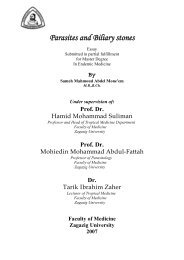Study of respiratory symptoms among sputum positive
Study of respiratory symptoms among sputum positive
Study of respiratory symptoms among sputum positive
You also want an ePaper? Increase the reach of your titles
YUMPU automatically turns print PDFs into web optimized ePapers that Google loves.
loss and persistent productive cough almost certainly has the disease if he<br />
or she lives in an area where tuberculosis is endemic or if he or she is a<br />
member <strong>of</strong> a group that has a high incidence <strong>of</strong>the disease, such as some <strong>of</strong><br />
immigrant communities in developed countries. The same <strong>symptoms</strong> in a<br />
native <strong>of</strong> a developed country would not immediately suggest the diagnosis<br />
and it would be more useful to consider other possibilities first (McNicol et<br />
al., 1995).<br />
Rossman and Mayock (1999), divided the <strong>symptoms</strong> into two<br />
categories constitutional and pulmonary. The most common constitutional<br />
symptom is fever, low grade at the onset but becoming marked ifthe<br />
disease progresses. Characteristically, the fever develops in the late<br />
afternoon and may not be accompanied by pronounced <strong>symptoms</strong> with<br />
defervescence, usually during sleep, sweating occurs. The classic (night<br />
sweats) other signs <strong>of</strong> toxemia such as malaise, irritability, weakness,<br />
unusual fatigue, headache and weight loss, may be present with the<br />
development <strong>of</strong> caseation necrosis and concomitant liquefaction, <strong>of</strong>the<br />
"'1 caseation, the patient usually notices cough and <strong>sputum</strong>, <strong>of</strong>ten associated<br />
LI I<br />
with mild haemoptysis. Chest pain may be localized and pleuritic.<br />
Shortness <strong>of</strong> breath usually indicates extensive disease with wide spread<br />
involvement <strong>of</strong> the lung and parenchyma or some form <strong>of</strong>tracheobronchial<br />
obstruction and therefore usually occurs late in the course <strong>of</strong>the disease.<br />
Physical signs<br />
There may be no physical signs in pulmonary tuberculosis even with<br />
relatively advanced disease but there may be pallor, a hectic flush or<br />
cachexia in sever disease (Leitch, 2000). Physical examination <strong>of</strong>the chest<br />
is <strong>of</strong>ten completely normal early in the disease. The principal finding over<br />
37
















